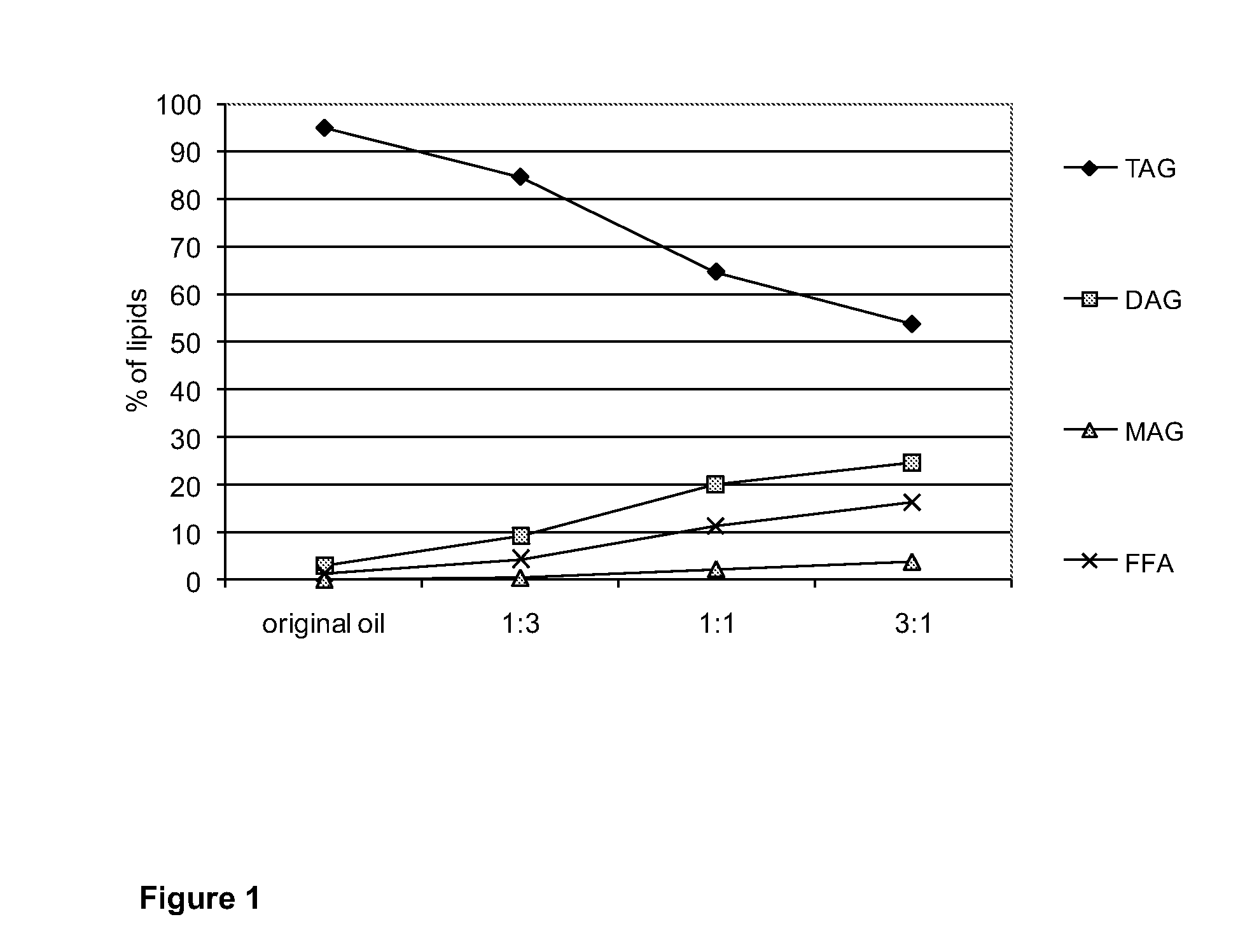Method for Purifying Lipid Material
a technology of lipids and lipids, applied in the field of lipid material purification, can solve the problems of metal and phosphorus content that is catalyst deactivation and plugging of the catalyst bed in the refining process, and undesirable impurities are difficult to remove from renewable source materials. , to achieve the effect of reducing the amount of phosphorus and metals, reducing the degree of phospholipid hydrolysis, and no nonpolar lipid hydro
- Summary
- Abstract
- Description
- Claims
- Application Information
AI Technical Summary
Benefits of technology
Problems solved by technology
Method used
Image
Examples
example 1
[0099]Rapeseed oil (Raisio) was purified by diluting it with heptane in a ratio of 1:3, and washing this oil-heptane solution with equal amount of water by stirring these components in a pressure reactor. In other words, a mixture of 40 g rapeseed oil, 120 g heptane, 160 g distilled water was mixed with a blade mixer in a 1 liter pressure reactor using a mixing efficiency of 500 rpm at varying temperatures for 30 min. Subsequently, the phases were separated by centrifugation. The upper non-polar phase was collected and the solvent heptane was evaporated therefrom in a rotavapor to recover the purified oil component.
[0100]The total amount of free fatty acids in the oil was determined by GC before and after the described treatment and after lipid saponification and methylation required for the GC sample preparation. The removal of phosphorus and metal impurities of the oils were analyzed by ICP. The lipid profile was analysed by GPC. The recovered and separated solids were analysed by...
example 2
[0106]The treatment for rapeseed oil described in Example 1 was performed at 230° C. by varying the oil-heptane ratios. The treatment was done at oil-heptane ratios 1:3, 1:1, and 3:1. The oil-heptane mixture had a mass of 160 g. The water amount used was equal to the nonpolar oil-heptane phase. On test was done with oil-heptane ratio 1:3 but with 5 wt-% water. The results are presented in Table 2 and. FIG. 1.
[0107]The result show that the oil diluted with the largest amount of non-polar solvent was hydrolysed the least in the treatment. When the treated oil was diluted in three parts heptane the decrease in TAG content was only 11%. When the oil contained 25% heptane, more than half of the TAGs (54%) were still unhydrolysed. When decreasing the amount of water from 50 wt-% to 5 wt-% there was slightly more TAGs unhydrolysed, however, only slightly more phosphorus (1.1 ppm) was left in the oil.
[0108]This example indicates that the nonpolar solvent protects the nonpolar oil from hydro...
example 3
[0112]Nannochloropsis oil, extracted from wet biomass at 100° C. with heptane and ethanol (3:1), was treated by diluting it with heptane in a ratio of 1:3, and treating this oil-heptane solution with water-ethanol (1:3) solution of equal mass in a stirred pressure reactor at set temperature. In other words, a mixture of 40 g oil, 120 g heptane, 40 g ethanol and 120 g distilled water was mixed in a 1 liter pressure reactor (mixing 500 rpm) at set temperature for 60 min. After this the phases were separated by centrifugation. The upper non-polar phase was collected and the solvent evaporated in a rotavapor to recover the purified oil.
[0113]The total fatty acids of oil before and after treatment was determined by GC after lipid saponification and methylation. Impurities of the oils were analyzed with ICP-analysis. The lipid profile was analysed by GPC-analysis. The separated solids were analysed by IR after drying.
[0114]This oil was purified with the described treatment at 200° C. and ...
PUM
| Property | Measurement | Unit |
|---|---|---|
| temperature | aaaaa | aaaaa |
| temperature | aaaaa | aaaaa |
| temperature | aaaaa | aaaaa |
Abstract
Description
Claims
Application Information
 Login to View More
Login to View More - R&D
- Intellectual Property
- Life Sciences
- Materials
- Tech Scout
- Unparalleled Data Quality
- Higher Quality Content
- 60% Fewer Hallucinations
Browse by: Latest US Patents, China's latest patents, Technical Efficacy Thesaurus, Application Domain, Technology Topic, Popular Technical Reports.
© 2025 PatSnap. All rights reserved.Legal|Privacy policy|Modern Slavery Act Transparency Statement|Sitemap|About US| Contact US: help@patsnap.com

